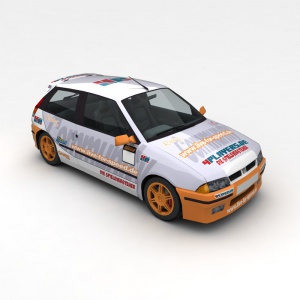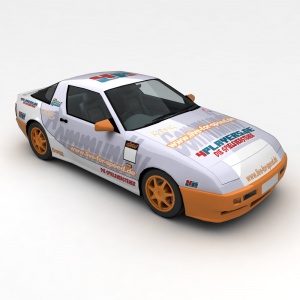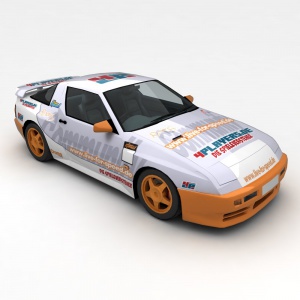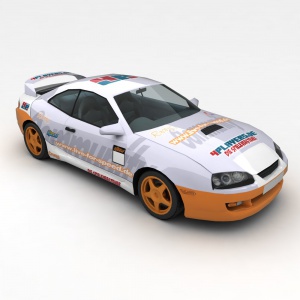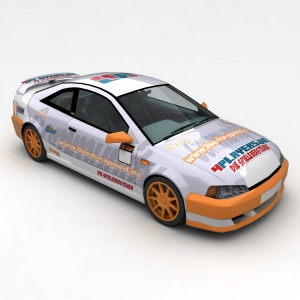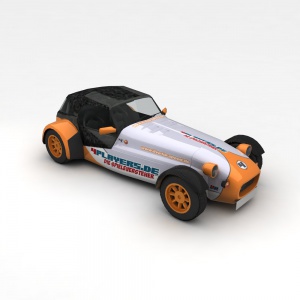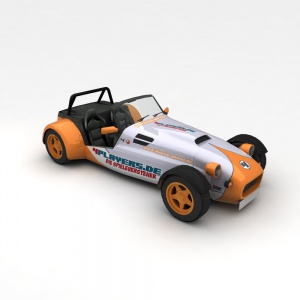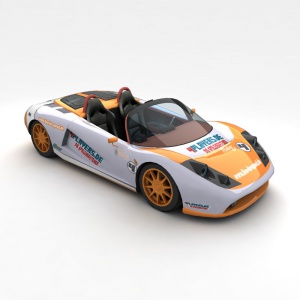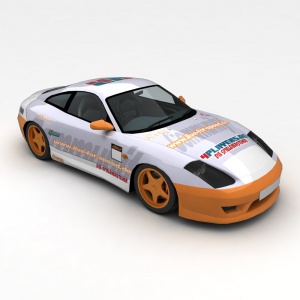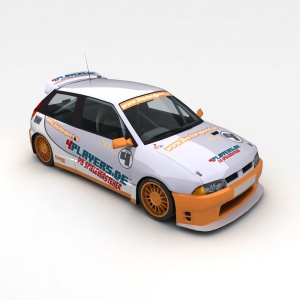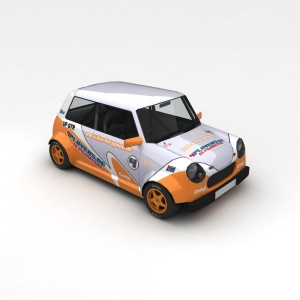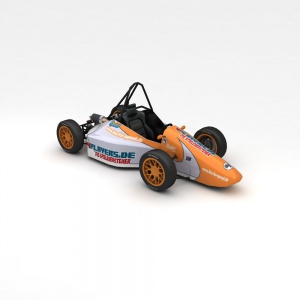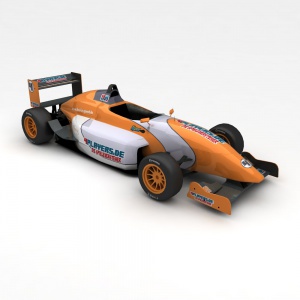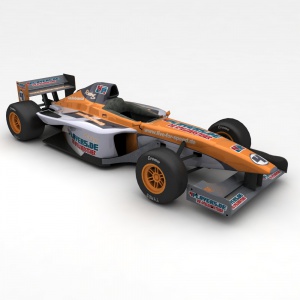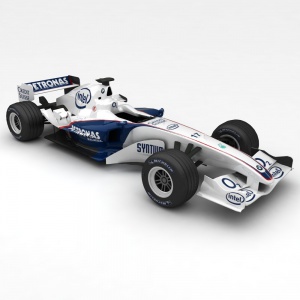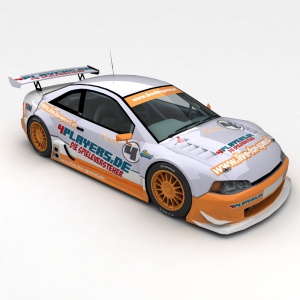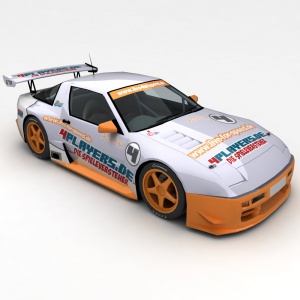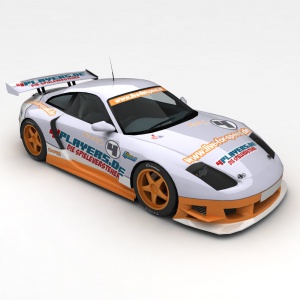Différences entre versions de « Voitures »
(→S2) |
(→S2) |
||
| Ligne 104: | Ligne 104: | ||
*'''XF GTR''' (XFR) - Légère et puissante version racing de la XF GTI équipée de pneus slick. | *'''XF GTR''' (XFR) - Légère et puissante version racing de la XF GTI équipée de pneus slick. | ||
*'''UF GTR''' (UFR) - Version puissante de la UF 1000. Train plus large et pneus slick | *'''UF GTR''' (UFR) - Version puissante de la UF 1000. Train plus large et pneus slick | ||
| − | *'''Formula XR''' (FOX) - | + | *'''Formula XR''' (FOX) - Petite voiture de course, similaire à une Formule Renault 2000 |
| − | *'''Formula V8''' (FO8) - | + | *'''Formula V8''' (FO8) - Voiture de course basée sur une Formule 3000 / GP2 |
| − | *'''BMW Sauber''' (BF1) - | + | *'''BMW Sauber''' (BF1) - Une création basée sur la version 2006 de BMW Sauber Formula One racecar |
| − | *'''FXO GTR''' (FXR) - | + | *'''FXO GTR''' (FXR) - Voiture 4 roues motrices, version racing de la FXO Turbo, équipée d'ailerons. Similaire aux GT500 |
| − | *'''XR GTR''' (XRR) - | + | *'''XR GTR''' (XRR) - Version racing plus légère que la XR GT Turbo, avec ailerons. |
| − | *'''FZ50 GTR''' (FZR) - | + | *'''FZ50 GTR''' (FZR) - Version racing plus légère que la FZ50 Turbo, avec ailerons |
== Car details == | == Car details == | ||
Version du 4 septembre 2007 à 08:19
Sommaire
LFS S2 compte au total 19 véhicules. Elles peuvent être classées en différentes catégories.
FR
XFG & XRG : Une traction citadine et un coupé propulsion avec environ 125 chevaux par tonne.
TBO
XRT, FXO & RB4: Des coupés soprts turbocompressés mus par 205ch/t. Une traction, une propulsion et une quatre roues motrices.
LRF
LX6, RAC & FZ5: Se rapprochant de la catégorie TBO. Toutes des propulsions. Ce genre de véhicules est très différent en terme de poids et de puissance. Elles vont de 250 à 310 ch/t. Certaines favorisent l'accélération et la maniabilité alors que d'autres se débrouillent mieux en vitesse de pointe.
Traction GTR
XFR, UFR: Environ 300ch/ton.
Propulsion GTR
FXR, XRR & FZR: Voitures de courses identiques aux Super GT japonaises (anciennement JGTC) classe GT500. Environ 410ch/t.
Route
Voitures de série.
Course
Voitures de course.
S1
| S1 cars | ||||||
| Modèle | Abbréviation | Carrosserie | Conduite | Moteur | Puissance | Poids |
|---|---|---|---|---|---|---|
| XF GTI | XFG | FF hatchback | FWD | inline-4 | 115 hp (86 kW) | 2073 lb (940 kg) |
| XR GT | XRG | FR coupe | RWD | 1.8 L inline-4 | 140 hp (104 kW) | 2536 lb (1150 kg) |
| XR GT Turbo | XRT | FR coupe | RWD | turbo inline-4 | 247 hp (184 kW) | 2695 lb (1223 kg) |
| RB4 GT | RB4 | 4WD coupe | AWD | 2.0 L turbo inline-4 | 243 hp (181 kW) | 2707 lb (1228 kg) |
| FXO Turbo | FXO | FF coupe | FWD | flat-4 | 234 hp (175 kW) | 2512 lb (1140 kg) |
| LX4 | LX4 | FR roadster | RWD | 1.3 L inline-4 | 140 hp (105 kW) | 1101 lb (499 kg) |
| LX6 | LX6 | FR roadster | RWD | 1.8 L inline-6 | 190 hp (142 kW) | 1188 lb (539 kg) |
| MRT5 | MRT | MR kart | RWD | 600 cc turbo inline-4 | 64 hp (48 kW) | 486 lb (221 kg) |
- XF GTI (XFG) - Front-wheel drive hatchback, similar to European hatchbacks such as the Peugeot 106 and Golf GTI
- XR GT (XRG) - Rear-wheel drive, front engined coupe, similar to a Mitsubishi Starion, Porsche 944, or Mazda RX-7 FC
- XR GT Turbo (XRT) - XR GT with a larger engine and turbocharger
- RB4 GT (RB4) - Four-wheel drive, front-engined coupe, similar to a Toyota Supra or Celica GT4
- FXO Turbo (FXO) - Front-wheel drive, front-engined coupe, similar to the Vauxhall/Opel Astra Coupe
- LX4 - Rear-wheel drive, front engined, LFS gets it's very own Lotus Seven replica, not too dissimilar to the Catermhams and Westfields of this world
- LX6 - Much like the LX4, this sports a more powerful engine, although this weighs it down more you'd never realise given the way it accelerates
- MRT5 (MRT) - Small open-wheel racecar somewhat larger than a kart, based on the real MRT5 built by the McGill Racing Team to compete in the Formula SAE championship
S2
| S2 cars | ||||||
| Model | Abbr. | Layout | Drive | Engine | Output | Weight |
|---|---|---|---|---|---|---|
| UF 1000 | UF1 | Citadine | Tractuib | 1.0L 4 cylindres en ligne | 55 ch. (41 kW) | 600 kg |
| RaceAbout | RAC | Décapotable | Propulsion | 2.0 L turbo 4 cylindres en ligne | 245 ch (183 kW) | 800 kg |
| FZ50 | FZ5 | Coupé | Propulsion | 3.6 L 6 cylindres à plat | 360 ch (269 kW) | 1380 kg |
| XF GTR | XFR | Voiture de course | Traction | 2.0 L 4 cylindres en ligne | 230 ch(172 kW) | 840 kg |
| UF GTR | UFR | Voiture de course | Traction | 1.4 L 4 cylindres en ligne | 180 ch (134 kW) | 600 kg |
| Formule XR | FOX | Formule MR | Propulsion | 2.0 L 4 cylindres en ligne | 190 ch(142 kW) | 490 kg |
| Formule V8 | FO8 | Formule MR | Propulsion | 3.0 L 8 cylindres en V | 450 ch (335 kW) | 600 kg |
| BMW Sauber | BF1 | Formule MR | Propulsion | 2.4 L V8 | 720 ch (537 kW) | 530 kg |
| FXO GTR | FXR | Voiture de course FR | 4 roues motrice | 2.0 L turbo 4 cylindres à plat | 490 ch (365 kW) | 1120 kg |
| XR GTR | XRR | Voiture de course FR | Propulsion | 2.0 L turbo 4 cylindres en ligne | 490 ch (365 kW) | 1100 kg |
| FZ50 GTR | FZR | Voiture de course RR | Propulsion | 3.6 L 6 cylindres à plat | 490 ch (365 kW) | 1100 kg |
- UF 1000 (UF1) - Petite voiture à traction, similaire à la Mini
- Raceabout (RAC) - Voiture open-top à propulsion, basée sur la véritable RaceAbout'02 fabriquée par les étudiants de l'Université de Finlande.
- FZ50 (FZ5) - Propulsion, moteur en position arrière, identique à une Porsche 911.
- XF GTR (XFR) - Légère et puissante version racing de la XF GTI équipée de pneus slick.
- UF GTR (UFR) - Version puissante de la UF 1000. Train plus large et pneus slick
- Formula XR (FOX) - Petite voiture de course, similaire à une Formule Renault 2000
- Formula V8 (FO8) - Voiture de course basée sur une Formule 3000 / GP2
- BMW Sauber (BF1) - Une création basée sur la version 2006 de BMW Sauber Formula One racecar
- FXO GTR (FXR) - Voiture 4 roues motrices, version racing de la FXO Turbo, équipée d'ailerons. Similaire aux GT500
- XR GTR (XRR) - Version racing plus légère que la XR GT Turbo, avec ailerons.
- FZ50 GTR (FZR) - Version racing plus légère que la FZ50 Turbo, avec ailerons
Car details
UF 1000 (UF1)
Front engined, front wheel drive
Engine: 1.0 litre inline 4
Power: 41 kW (55 bhp) @ 5589 rpm
Torque: 88 Nm (65 lbft) @ 3009 rpm
Total Mass: 600 kg (1323 lbs) (572 kg (1262 lbs) Open Top)
Power-weight: 69 W/kg (93 bhp/ton) (72 W/kg (98 bhp/ton) Open Top)
Weight dist: 59.9 F 40.1 R (61.2 F 38.8 R Open Top)
Fuel tank capacity: 35 ltr
The least powerful car in the game, but far from being the least fun. In fact, the closest races are to be had when behind the wheel of this car. Certainly not suited to the faster tracks however.
Setup tip: Stiffer springs than usual to make up for the lack of antiroll bars, and will help generate some tyre heat. Pump plenty of air into those rear tyres or it will understeer to hell.
XF GTI (XFG)
Front engined, front wheel drive
Engine: 1.3 litre inline 4
Power: 86 kW (115bhp) @ 6871 rpm
Torque: 130 Nm (96 lbft) @ 5658 rpm
Total Mass: 940 kg (2072 lbs)
Power-weight: 92 W/kg (125 bhp/ton)
Weight dist: 60.0 F 40.0 R
Fuel tank capacity: 45 ltr
An excellent car for beginners and experts alike, no other car in LFS is so universally driven as the XF GTi, from first-time-driver to seasoned league pro. It responds well to setup adjustments, and is a stable chassis that will teach a driver some invaluable lessons about pushing it to its limits, whilst retaining a degree of inherent stability and forgiving handling.
Setup tip: Don't overlock the differential, although more power-locking helps put the power down since the XF GTi doesn't have a two-way adjustable differential, you will also kill off the oversteer that you'll need to put into the setup to make the car steerable with the throttle.
XR GT (XRG)
Front engined, rear wheel drive
Engine: 1.8 litre inline 4
Power: 104 kW (140bhp) @ 5945 rpm
Torque: 186 Nm (137 lbft) @ 4603 rpm
Total Mass: 1167 kg (2572 lbs)
Power-weight: 90 W/kg (122 bhp/ton)
Weight dist: 54.3 F 45.7 R
Fuel tank capacity: 65 ltr
A perfect car for practicing the fine art of driving RWD on the limit. Plenty of power to keep even the most tail happy drivers amused, but not enough to brown your pants on every exit. A car that will pave the way to handling some of the more frightening motors out there in LFS. A good match for the XF GTi although slightly faster (in a straight line)!
Setup tip: A fairly neutral setup is best for this car since it suffers very little from power oversteer. Play with differential locking so you can steer with the throttle to your liking.
XR GT Turbo (XRT)
Front engined, rear wheel drive
Engine: 2.0 litre turbocharged inline 4
Power: 183 kW (245bhp) @ 6019 rpm
Torque: 325 Nm (239 lbft) @ 4585 rpm
Total Mass: 1224 kg (2699 lbs)
Power-weight: 150 W/kg (204 bhp/ton)
Weight dist: 52.5 F 47.5 R
Fuel tank capacity: 75 ltr
Take the XR GT, enlarge the engine to a nice round 2 litres, chuck a turbocharger under the bonnet for good measure and give it some meaner bodywork, and the XR GT Turbo is born. Although infamous for it's turbo lag, it does actually drive very nicely once you have become used to its handling and rather unique power delivery. Old timers still call it the GTT.
Setup tip: Just a touch of understeer is all that's need to control this car, once you've learnt to anticipate the turbo lag it's really just a more powerful XR GT.
RB4 GT (RB4)
Front engined, all wheel drive
Engine: 2.0 litre turbocharged inline 4
Power: 181 kW (243bhp) @ 6021 rpm
Torque: 340 Nm (250 lbft) @ 3886 rpm
Total Mass: 1235 Kg (2723 lbs)
Power-weight: 147 W/kg (200 bhp/ton)
Weight dist: 56.4 F 43.6 R
Fuel tank capacity: 75 ltr
The only road car to sport an AWD drivetrain, this makes it the ideal car for all the rallycross courses. The RB4 is also fun to drive on the road tracks, but is slightly slower than the GT Turbo and FXO due to the mechanical loss inherited from the AWD layout. It is the easiest to drive out of the trio, however.
Setup tip: Understeer is your enemy here. Only add as much as you feel you need into the suspension and push the torque split back until you can push the rear out slightly with the throttle. This will also help even out tyre heating & wear.
FXO TURBO (FXO)
Front engined, front wheel drive
Engine: 1.9 litre turbocharged flat 4
Power: 175 kW (234 bhp) @ 6365 rpm
Torque: 305 Nm (224 lbft) @ 4338 rpm
Total Mass: 1132 kg (2495 lbs)
Power-weight: 154 W/kg (210 bhp/ton)
Weight dist: 59.3 F 40.7 R
Fuel tank capacity: 75 ltr
The favorite car in S1 (initially), it is very accessible and fun, being a fast front wheel driven car. It's meaty tyres and light weight ensures it is corners well. The XRT catches back up on long straights though.
LX4 (LX4)
Front engined, rear wheel drive
Engine: 1.3 litre inline 4
Power: 105 kW (140 bhp) @ 8212 rpm
Torque: 131 Nm (97 lbft) @ 6917 rpm
Total Mass: 499 kg (1100 lbs)
Power-weight: 210 W/kg (286 bhp/ton)
Weight dist: 45.8 F 54.2 R
Fuel tank capacity: 40 ltr
Tipping the scales at a mere 518 kg, the LX4 is a pretty light car and is quite fast around the twisted S1 tracks. Compared to its bigger brother, the LX6, the LX4 is easy to drive and ideal for beginners to learn how to control a LX-style car.
LX4/6 Setup tip: These cars need a fair amount of understeer in the springs to keep the controllable. Don't go silly with the spring rates though. Low tyre pressures are needed. Keep the diff as open as possible on the power side and reasonable well locked on the coast side. Some rear toe comes in very handy here.
LX6 (LX6)
Front engined, rear wheel drive
Engine: 1.8 litre inline 6
Power: 142 kW (190 bhp) @ 8429 rpm
Torque: 173 Nm (128 lbft) @ 7059 rpm
Total Mass: 540 kg (1192 lbs)
Power-weight: 62 W/kg (357 bhp/ton)
Weight dist: 48.3 F 51.7 R
Fuel tank capacity: 40 ltr
Take the LX4, swap the engine for a 1.8 litre inline 6, and you have the LX6. So what's the big deal? It's a touch heavier, has a slightly more balanced weight distribution (due to the heavier lump up front) and, most importantly, more power. It's trickier to drive, so if you've not driven an LX style car before the LX4 is a better starting point. Since the LX8 has been canned, this is the fastest LX style car available in LFS at the moment.
RaceAbout (RAC)
Mid engined, rear wheel drive
Engine: 2.0 litre turbocharged inline 4
Power: 183 kW (245 bhp) @ 5879 rpm
Torque: 360 Nm (265 lbft) @ 3500 rpm
Total Mass: 800 kg (1763 lbs)
Power-weight: 228 W/kg (311 bhp/ton)
Weight dist: 40.0 F 60.0 R
Fuel tank capacity: 42 ltr
Website: http://www.raceabout.fi
Really existing prototype of a sportscar from Finland powered by a mid-mounted turbocharged Saab engine. Hard to be driven on the limit.
Setup tip: The lack of rear antiroll bar can make this awkward to setup. Don't put too much understeer into the springs or the car will push too much. No need to go silly with the front antiroll bar either, although a healthy amount is still recommended. Keep the suspension fairly soft too.
FZ50 (FZ5)
Rear engined, rear wheel drive
Engine: 3.6 litre flat 6
Power: 269 kW (360 bhp) @ 7588 rpm
Torque: 392 Nm (288 lbft) @ 5019 rpm
Total Mass: 1379 kg (3041 lbs)
Power-weight: 195 W/kg (265 bhp/ton)
Weight dist: 38.0 F 62.0 R
Fuel tank capacity: 90 ltr
This is the fastest road car available in LFS, favoring top speed over handling. Its high weight, high power and rearward weight distribution make for an challenging, yet entertaining drive. Go take it for a spin and make those tyres squeal. Setup tip: Doesn't actually need that much understeer. Heavy engine braking is the main issue, so most importantly have the differential very tight on the coast side to help with off throttle oversteer, and move the brake bias forward to help stability under braking.
XF GTR (XFR)
Front engined, front wheel drive
Engine: 2.0 litre inline 4
Power: 179 kW (240 bhp) @ 7242 rpm
Torque: 270 Nm (198 lbft) @ 5178 rpm
Total Mass: 836 kg (1843 lbs)
Power-weight: 214 W/kg (292 bhp/ton)
Weight dist: 62.3 F 37.7 R
Fuel tank capacity: 70 ltr
Take everyone's favourite hot hatch, stick slicks on it, thrown in a beastly 2.0 engine, throw out some weight, then clad it in some mean racecar bodywork and this is what you end up with. The most powerful FWD car in LFS, it brings a whole new meaning to the phrase "power understeer". Requires smooth driving. Is a competitor to the UF GTR.
XF/UF GTR setup tip: Wheelspin frying the front tyres is the main nightmare behind these cars, so keep the suspension soft, lock the differential as far as it will go on the power side and use the coast side to control lift off oversteer. Keep zero toe on the front wheels, and keep tyre pressures LOW. Although this makes the tyres easier to heat up, the extra grip will be more beneficial in preventing wheelspin, so in fact the tyres will generally be cooler.
UF GTR (UFR)
Front engined, front wheel drive
Engine: 1.4 litre inline 4
Power: 134 kW (180 bhp) @ 8246 rpm
Torque: 178 Nm (131 lbft) @ 5870 rpm
Total Mass: 600 kg (1323 lbs)
Power-weight: 223 W/kg (304 bhp/ton)
Weight dist: 64.6 F 35.4 R
Fuel tank capacity: 60 ltr
While it has less power than it's competitor, the XF GTR, it's lack of weight more than makes up for this. On twistier circuits it will eat the XF GTR (and a couple of sets of tyres), but loses out on the straights. Certainly requires smooth driving. Whoever said Minis were boring?
MRT 5 (MRT)
Mid engined, rear wheel drive
Engine: 600 cc turbocharged inline 4
Power: 48 kW (64 bhp) @ 7894 rpm
Torque: 69 Nm (51 lbft) @ 5071 rpm
Total Mass: 221 kg (486 lbs)
Power-weight: 217 W/kg (296 bhp/ton)
Weight dist: 37.5 F 62.5 R
Fuel tank capacity: 20 ltr
Website: http://www.fsae.mcgill.ca
Based on the real MRT5 built by the McGill Racing Team and competing in the Formula SAE championship this lightweight car is ideal for autocross tracks and slow configurations. The MRT5 is fun to drive and reminds you of a kart although it has more power and a differential.
Setup tip: This car is best with SOFT suspension. Understeer is certainly not needed in the springs, it hurts turning too much. Just adjust antiroll bars to get the balance you want. Also, this car is extremely sensitive to differential settings. Use the viscous differential and keep it fairly open (low single digits). Very low tyre pressures. Rear toe comes in handy again here.
Formula XR (FOX)
Mid engined, rear wheel drive
Engine: 2.0 litre inline 4
Power: 142 kW (190 bhp) @ 7032 rpm
Torque: 221 Nm (162 lbft) @ 4964 rpm
Total Mass: 490 kg (1079 lbs)
Power-weight: 290 W/kg (395 bhp/ton)
Weight dist: 45.0 F 55.0 R
Fuel tank capacity: 38 ltr
Based upon a Formula Renault 2000 racecar, this car serves as a nice introduction to the cars with downforce. The relatively low power of the engine makes the car easy to drive once up to speed. Insane fun on twisty tracks.
Setup tip: Actually needs a bit of a loose setup, this will help with low speed cornering. Adjust downforce to keep the rear in place at higher speeds. Due to it's low power, it's best to keep wing angles low for most tracks.
Formula V8 (FO8)
Mid engined, rear wheel drive
Engine: 3.0 litre V8
Power: 341 kW (458 bhp) @ 8972 rpm
Torque: 401 Nm (295 lbft) @ 7059 rpm
Total Mass: 600 kg (1323 lbs)
Power-weight: 568 W/kg (775 bhp/ton)
Weight dist: 45.0 F 55.0 R
Fuel tank capacity: 125 ltr
Based upon a Formula 3000 racecar, this is the second fastest but most difficult car to drive in LFS. Once mastered though, it offers great rewards to the driver. It's no Formula One car but don't let that fool you into thinking this isn't one awesome car. Just look at that power-to-weight figure! Suffice to say, the acceleration is incredible. It can pull over 3Gs in the bends. And if it stopped any quicker it would hurt (well, more-so). Only drive it if you have the balls.
Setup tip: Like the FOX, you don't really need much understeer, just use downforce to keep the rear in place. High tyre pressures work well on this car.
BMW Sauber F1 (BF1)
Mid engined, rear wheel drive
Engine: 2.4 litre V8
Power: 537 kW (720 bhp) @ 19076 rpm
Torque: 284 Nm (209 lbft) @ 16817 rpm
Total Mass: 530 kg (1169 lbs)
Power-weight: 1011 W/kg (1378 bhp/ton)
Weight dist: 46.3 F 53.7 R
Fuel tank capacity: 95 ltr
The real BMW Sauber F1.06. Incredibly fast in every way. You'll need to drive absolutely on the limit to get the most out of it. You don't need to lift or even use a gearstick for shifting - the onboard electronics will do it faster than you ever could.
Setup tip: Stiff suspension is way to go here, the tyres flex enough you just don't need the springs to. This also means you can use stiff anti-roll bars without screwing up the handling. High wing angles are needed to increase traction and make use of all that power. The traction control, although for girls, is definately useful to stop you pushing too hard. 4% is a good beginners limit, the more manly you feel, the higher you can go. Hardcore players like to leave it off all-together.
FXO GTR (FXR)
Front engined, all wheel drive
Engine: 2.0 litre turbocharged flat 4
Power: 365 kW (490 bhp) @ 6278 rpm
Torque: 627 Nm (461 lbft) @ 4782 rpm
Total Mass: 1130 kg (2492 lbs)
Power-weight: 323 W/kg (441 bhp/ton)
Weight dist: 57.5 F 42.5 R
Fuel tank capacity: 100 ltr
The FXO GTR is the easiest of the GTR cars to drive, thanks to its stable handling and four-wheel drive. Unfortunately it's also the slowest over a single lap. In the hands of a skilled driver it can usually beat most comers, but even the best FXO GTR driver can't catch a well-driven FZ50 GTR or XR GTR in a sprint race. In endurance races the playing field is leveled somewhat, as the FXO GTR is easier on its tires than the other two GTR cars and has superior fuel economy. Ultimately the FXO GTR is a great car for somebody just getting used to the extra power offered by the GTR cars or for somebody who just wants to have some fun in the GTR class, but if you want wins and don't like long races you have to move to one of the rear-wheel drive GTR cars.
Setup tip: Need a little oversteer for this car, and send plenty of the torque rearward to keep tyre temperatures equal front and rear. Best keep the differential locking fairly light on the coast side to help turn in, which is this cars main strength.
XR GTR (XRR)
Front engined, rear wheel drive
Engine: 2.0 litre turbocharged inline 4
Power: 365 kW (490 bhp) @ 6278 rpm
Torque: 627 Nm (461 lbft) @ 4782 rpm
Total Mass: 1100 kg (2424 lbs)
Power-weight: 332 W/kg (453 bhp/ton)
Weight dist: 55.4 F 44.6 R
Fuel tank capacity: 100 ltr
Is the XR GT Turbo not man enough for you? Slicks, wings, silly power and an angry face, this car has had the works done to it. Nobody knows what the LFS tuning division did to the turbocharger to get double the power out of the engine, but it works, and we are forever thankful. It likes to eat FXO GTRs for breakfast, so watch out.
XR/FZ50 GTR setup tip: Not much understeer needed for these cars, again just use downforce for high speed stability. Need to keep the differential fairly tight so you can put down all that power. Highish tyre pressures at the rear, less at the front.
FZ50 GTR (FZR)
Rear engined, rear wheel drive
Engine: 3.6 litre flat 6
Power: 365 kW (490 bhp) @ 8106 rpm
Torque: 503 Nm (370 lbft) @ 5267 rpm
Total Mass: 1100 kg (2425 lbs)
Power-weight: 332 W/kg (452 bhp/ton)
Weight dist: 35.3 F 64.7 R
Fuel tank capacity: 100 ltr
This is what happens when a not-so-sane person looks at the FZ50 and says "Mmm, nice, but could do with a bit more power." 130bhp more to be exact. Like the XR GTR, it was given slicks, downforce, gorgeous looks and lightened, but just ended up better. Not for the faint hearted, since it will do it's best to rip it out the first time you drive it.
Car Steering Wheel Lock Angles
720°
All of these cars use the full 720 degrees of rotation
XFG, XRG, XRT, RB4, FXO, LX4, LX6, UF1, UFR, XFR, FZ5
540°
These cars use a reduced lock of just 1.5 turns lock to lock
XRR, FXR, FZR
450°
These cars use 1.25 turns lock to lock
FO8, BF1
270°
The only car to use less than one full turn, required a flick of 0.75 turns lock to lock
MRT


